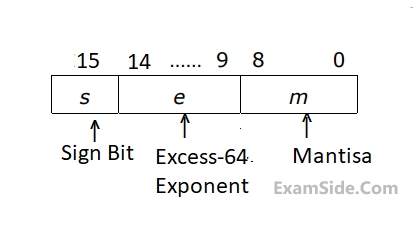1
GATE CSE 2003
MCQ (Single Correct Answer)
+2
-0.6
The following is a scheme for floating point number representation using $$16$$ bits.


Let $$s, e,$$ and $$m$$ be the numbers represented in binary in the sign, exponent, and mantissa fields respectively. Then the floating point number represented is
$$\left\{ {\matrix{ {{{\left( { - 1} \right)}^s}\left( {1 + m \times {2^{ - 9}}} \right){2^{e - 31}},} & {if\,the\,{\mathop{\rm exponent}\nolimits} \, \ne \,111111} \cr {\,\,\,\,\,\,\,\,\,\,\,\,\,\,\,\,\,\,\,\,\,\,\,\,\,\,\,\,\,\,\,\,\,\,\,\,\,\,\,\,\,\,\,\,0} & {otherwise\,\,\,\,\,\,\,\,\,\,\,\,\,\,\,\,\,\,\,\,\,\,\,\,\,\,\,\,\,\,\,} \cr } } \right.$$
What is the maximum difference between two successive real numbers representable in this system?
2
GATE CSE 2002
MCQ (Single Correct Answer)
+2
-0.6
Sign extension is the step in
3
GATE CSE 1999
MCQ (Single Correct Answer)
+2
-0.6
Booth’s coding in $$8$$ bits for the decimal number –$$57$$ is:
4
GATE CSE 1999
MCQ (Single Correct Answer)
+2
-0.6
The number of full and half-adders required to add 16-bit numbers is:
GATE CSE Subjects
Theory of Computation
Operating Systems
Algorithms
Digital Logic
Database Management System
Data Structures
Computer Networks
Software Engineering
Compiler Design
Web Technologies
General Aptitude
Discrete Mathematics
Programming Languages
Computer Organization